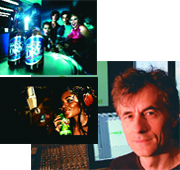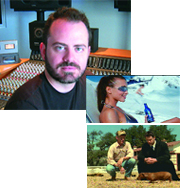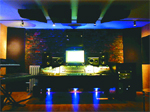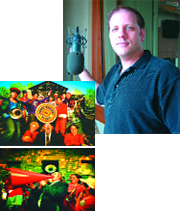
Serge Laforest says Audio Z uses a Euphonix CS2000 and Pro Tools|HD for spot work. Recent work includes ads for 7up and LaBatt (inset).
|
With our ever-diminishing attention span, ad agencies and their clients need to grab and keep viewers' attention within the first seconds of a commercial spot. And this sometimes makes for a tense but highly creative work environment.
After all, this is not an inexpensive proposition. Companies are spending millions of dollars to make sure their message is seen and heard. So, in tandem with having the best technology available, audio post houses make sure their talent also has the ability to delicately balance personalities during a session.
THE HUMAN FACTOR
LA-based Ravenswork ( www.ravenswork. com) chief engineer Eric Ryan performs final mixes on spots, so he brings together everything from voiceover to music to sound design. Ryan reports that the majority of his work includes national spots for clients such as Intel, Nissan and Sony PlayStation. The direction he receives from clients depends upon who shows up for the mix session.
"Sometimes we'll have an editor's assistant here all the way up to the creative director from the agency and possibly their client," he reports. "So, a lot of times you have to juggle their hierarchy - you'll have a junior writer who wants one thing, and you'll go down this path for three or four hours on a mix, then the creative director will show up and want something totally different. So, you have to be able to really humor just about everybody in the room, depending on what the time allows."

Ravenswork's Eric Ryan (top) has worked on spots for Skyy Blue and Sprint using Fairlight's MFX3plus and FAME.
|
Ryan's first goal is to get the spot to where it will sound good on air. "Then it comes to a point where it's playing around with subjectivity," he explains. "Sometimes it gets a little heated with the egos, so to speak, as to who you have to be really listening to and what's going to end up being the best result. It gets to be a political situation sometimes."
The way he resolves any tension is to explore everyone's ideas. "At that point it becomes obvious to the room whether or not it's a good idea," he says. "Basically, as they are talking I can be doing what they are saying and then as soon as they are done with their comment I hit play and it's obvious whether or not it works. If it doesn't, I hit undo and go down some other road."
As for the technology that Ravenswork uses, Ryan says it's predominantly Fairlight's MFX3plus and FAME, although they do have Pro Tools so they can interface with the rest of the world. "We have found that the Fairlight, as far as speed and stability, far exceeds what we could do with a Pro Tools system," he says.
When it comes to mixing a spot, Ryan believes the key is making sure there is space for everything to be heard. "If you get something that's a little more exploratory with esoteric sound design elements, make sure that's coming across in a good way and not just a mess," he explains. "Or if the copy is really selling the spot, then the simplicity of what's around it works a lot better. If it's a music-driven spot, make sure that shines and isn't swallowed up by a bunch of explosions."

For its advertising work, Blue Room employs Pro Tools|HD and a Focusrite Control 24 console.
|
FINDING THE RIGHT FLOW
Brian Aumueller, senior composer at New York City-based Blue Room (www. blueroompro.com), says he faces many challenges while working on promo spots for networks such as TBS, ESPN and CNN. "I think the first thing when you are given a visual is finding the right pulse and really nailing the most effective way to give that visual life with music or sound effects," he explains.
Overcoming that depends on the spot. Aumueller points to a redesign campaign the company recently did for TBS. "Every couple of years they'll redesign their whole network with new promo spots. In this case we started with storyboards rather than video. That was an interesting place to begin, because immediately you start developing ideas about what the sound may be for that spot musically," he says. The company then received video of actors shot against greenscreens, which enabled them to work with sound design and music sans graphics. It was an interesting challenge, he adds, because the more visual material they received the more he could hone in the audio.
"Sometimes you'll work out a piece and the flow will just about be right, but then some things will change and certain edits will be made. You then have to rethink where the music needs to go because the bottom line is that the piece has to have a flow to it," Aumueller says. "We encountered that with the redesign because it was an ongoing process right up to the deadline."

AudioEngine recently completed work on this Honey Bunches of Oats commercial. Recording engineer/sound designer Tom Goldblatt is pictured.
|
As far as tools, Blue Room uses Pro Tools|HD as their main system with a Focusrite Control 24 board. Aumueller employs a handful of modules and synthesizers, including a Yamaha Motif, a Roland Phantom, a Kurzweil K2000 and a Trident. "It's a good mix, because one particular brand might have a great strength, but it's when you use the different brands in union with one another that you can get really wild and crazy," he says.
Based on his experience, Aumueller reports that the key to creating exciting music for promos or spots is going above and beyond what's already airing. "You really need to inject these spots with something unique and creative. I'd like to think that when I'm writing music to a spot that it's really my voice. As a composer you have a whole bunch of things in your bag of tricks," he says. "It's about how effective the visuals will lock up with the music and sound design, and about the actual piece of music -whether or not you can tell a story over 30 seconds. I think the same thing applies to a spot that's two minutes or 10 minutes. Any writer should really challenge themselves to bring their voice to these spots."
ADS VS. PROMOS
At SoundHound (www.soundhound. com) in Manhattan the biggest challenge is working under tight deadlines says mixer James Von Buelow. Whether it's promo spots for the Food Network or the USA Network, the important thing is to work quickly so the spots can air. "The Food Network will come in here and mix six or seven spots in two hours," Von Buelow explains. "Then USA will come in and we'll be able to spend all day on the same amount of spots. USA is going to be more intensive about sound effects, making it more like a movie trailer for every movie that they [promote]. For the Food Network it's about adding a few effects here and there, making it sound good and getting it on the air."
Von Buelow likes that approach. "It's great. It's like mixing little trailers all the time, so it is a lot of fun and you get to be kind of creative with some sound design," he says. "The only drawback is that you're having to do it so quickly. You get used to that pace and you put out good stuff regardless." Von Buelow uses a Fairlight MFX3 to get the work done.

SMP re-records classic for Mercedes
|
After the first couple of sessions with a producer, Von Buelow reports that he's afforded a bit of freedom. "During the first few sessions they are kind of feeling you out and watching everything you do," he reports, "but then it gets to a point where they give you the tape and they make their phone calls. You mix the spot and you ask them to pay attention for the playback and they say, 'Okay fine,' or they say, 'Change this a little bit.' But they kind of leave it in your hands."
There is a major difference in the vibe of the session, he says, between promo work and spot work. "With promo work usually it's just the one person coming in; with ad work there's an entourage coming in - the copywriter, the editor. And you might spend two hours just doing the VO. For promo work, the guy will come in and in 15 minutes we have a final tape for all the spots that we need to do," he explains. "It moves much quicker, there's much less politics involved. Obviously, there's a lot less revisions because things are much closer to a deadline as well. So, it's not like they take it back and there's 16 things they want to change and come back the next day. Ad work can be revision crazy."
Yet, he says, it is the same basic concept for promos, with one caveat. "I think generally you're trying to convey it in a louder way," he says. "It's mini movie trailers all the time. They're more high impact with not a lot of subtleties."
And at times that can be more fun. Take the recent Highlander and Terminator 2 package he recently completed for the USA Network. "They are sound effects intensive, so you go through your libraries of sound effects and put these things together. It's really a lot of fun. [The producers] leave it in my hands pretty much, [although] they might have a suggestion like let's get a different kind of explosion for that or a different karate punch," Von Buelow explains. "It's very collaborative that way. Where in ad work they'll have a sound designer do the sound design before they come into see you, and you'll just insert that sound design and do a little tweaking. It's different in that way."
DIVERSITY FEEDS CREATIVITY
The composition team at Montreal-based Audio Z (www.audioz.com) takes turns working on the sometimes disparate creative outlets of advertising and art films. "It's kind of bizarre, but it's fun," explains Audio Z president Serge Laforest, who believes that their work on art films as well as spots gives them an edge. "Clients say, 'Those guys can do Budweiser stuff and also art films - completely weird atmospheric art films.' It's good, mentally, to be able to go from one to the other, to do something wild where you don't have any limit. You don't have to sound like anybody else, you can just do what you want. It's refreshing for us, and clients like that we're associated with those types of projects as well. One feeds the other.'"
In addition to composition work for spots airing in Canada, Audio Z offers an array of post services from sound design to sound effects to full Dolby Surround mixing. Their composition work has been heard on spots for automobiles (Volkswagen, Toyota), pharmaceutical companies (Pharmaprix) and phone companies (Telus) to name a few. "We do lots of American ads here that are translated into French or adapted where we do the singer or the voiceovers in French," Laforest explains.

While taking the work seriously, Another Country's John Binder makes every job fun.
|
Audio Z is a Pro Tools|HD house and boasts a Euphonix CS2000 console along with a cadre of online sound effects and stock music libraries that can be used in conjunction with their original music.
While the company handles TV spots, they are also do radio work, which offers them the opportunity to direct spots. It's a different type of session than a television date, Laforest explains. "In Canada, for TV spots, there's always a director that shoots the spot and has an influence on the post. Often they will recommend a composer and will supervise. In the case of radio, it's often the studio that will be responsible for helping to put the concept together."
SOME SOUND DESIGN IN THE FINAL MIX
In NYC, AudioEngine (www.audioengine. net) recording engineer/sound designer Thomas Goldblatt has seen a change in the spot mixing sessions he's performing lately "These days I feel like we're doing more sound design [but not complete sound design] with the mixing," he reports. "Everything is on such a tight schedule that there's always one more thing needed, there's always a change in the cut and everyone is moving on a tight schedule, so sound design is becoming more expected in the final mix - or your enhancing sound design that was already done."
Part of that, he adds, is because the audio mix is the final stage of the process before a spot is aired. "I tend to do an overall final quality control check," says Goldblatt. "Because of the schedule a lot of pressure is put on the clients to deliver these things fast. I also find that besides doing the audio mix I try to work with my clients and make sure they've crossed all their t's and dotted all their i's."
This is something that Goldblatt's clients appreciate. "Any time you can bring more to the party it helps the situation," he says. "You don't want to be heavy handed about anything, it's not like you're taking over the session, but you can play a supporting role in other venues, besides your audio mixing expertise, especially in commercials where the turnaround is so tight."
Goldblatt bounces between Pro Tools and Avid AudioVision. "I don't really have a preference anymore," he admits. "It depends on how things are prepped. Pro Tools is going to become the de facto standard, but for post there's still a few things that it needs to do that it doesn't do in the way of dialogue conform and stuff like that. There was a while where we stopped doing dialogue conform because the editor's were doing it in their OMF set-ups. But it's sort of swinging back again that the OMFs don't have the final audio from dialogue and they want us to redo the conform."
More than gear, he adds, studios must have top-of-the-line talent. "At the high end commercial studio, whatever gear the mixer chooses is going to be of a certain caliber, and it's all fine. It's really the individual mixer that brings his own special touch to it, and that's why people are there," he says. "It used to be that the equipment was so expensive you could only go to a couple places if you wanted high-end work. Don't get me wrong, it's still not cheap and you still have to build it right - the room still has to be acoustically sound - but every high-end place now can afford the top equipment. I don't think there are any compromises being made that way, so I think it comes down to the individual mixer now."
Goldblatt reports that recent projects include spots for Mercedes-Benz, Post Cereal and Stay Free.
MAKING EVERY PROJECT FUN
Based in Chicago, one of the advertising market's hotspots, Another Country (www. anothercountry.net) has worked with a range of clients, including Toys 'R' Us, Coke, Morgan Stanley, NASCAR and Sears. You'd think they would approach each spot differently. Not so, says mixer/ sound designer John Binder. "Some people, when they're working on a Bud or Coke [campaign] think they can have fun now. We approach every job in the same way," he says. "I think that's part of our forte, checking the egos at the door and coming in and having fun with the project. Sometimes you get projects that are dogs and our client's client has a heavy hand in it and it's not fun at all. But I've got to say that some of the things we do for Applebee's are a hoot; they are a lot of fun to work on."
No matter what the project, Another Country was built with the knowledge that revisions are the norm in the advertising market. Three of the company's rooms are outfitted with similar Pro Tools|HD systems. "We're a little unconventional," Binder reports. "We have a Fibre Channel array where we have a pool of drives in our machine room, so we're always looking at the same set of drives all the time. We hand off jobs extremely quickly from one room to another because the nature of our business is that revisions are a must. So, we all have the same mix set-up, we all have pretty much the same philosophy approaching a mix and we can hand one job off to the other."
Just what is that mix philosophy? "The client is always right," Binder answers with a laugh. "We offer them options they may not have thought of, but ultimately it's their decision. We push for our ideas, but we don't fall on our sword for them. The other thing I say to my guys is that it's important to know when not to play. It's kind of a musician's philosophy. There's many times sound designers and mixers think, 'Oh, the more stuff I pack in here the greater it will be and the fatter it will sound.' Well, many times it just sounds muddy. So, pick and choose your sounds carefully and choose how they are going to live with their neighbors, meaning what sounds you put with other sounds. The mix philosophy is just keep it as clean as possible."
Another Country has also taken care to make sure the facility is up to speed on the information superhighway. "One of our fortes is our seamless integration with the Internet," Binder reports. "We can post a QuickTime in less than three minutes or post an MP3 in less than 30 seconds."
Making their sessions that accessible was important for a simple reason, Binder says. "Anytime we can get feedback from our clients it's great. We can work in a vacuum and go down a road that you think is just awesome and then when they see it you're back to square one again."